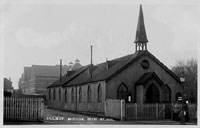
Railway Mission Hall
Quick links on this page
New C of E Dioceses 1914
St George's 1951
All Saints 1962
Free Church 1987
Seventh Day Adventists 2002
Bottom of Page 2015
|
Alternative and Non-Conformist Religion
After 1900
|
1900
|
The Railway Mission was a charity founded in 1881 to bring the Gospel to people working on the railways. The railways employed thousands of men who often had to work during normal church hours. In 1895, local railwaymen approached Mrs Arthur Ridley, about starting a railway mission in Bury St Edmunds. Mrs Ridley was a widow, and a Congregationalist from the Northgate Street Chapel, and she began by leading services at the station.
Since 1895 a room in the Station Master's house by the Northgate railway station in Bury St Edmunds had been used as the mission to railwaymen who worked on the Bury line. By 1900 the pressure of numbers was such that a larger venue was required.
Soon they had raised enough money amongst themselves, and the mission hall was ordered.
So on 20th May, 1900 the Railway Mission was opened in Bury St Edmunds, at Fornham Road, just past the railway bridge by the Mayor, Councillor Thomas Shillitoe. Many local town and church dignitaries were present. It was pre-fabricated building, of the type which became called the "tin tabernacle."
There were companies all over the country who could provide similar buildings in kit form including Boulton and Paul in Norwich.
The tabernacle at Bury was put up by W Hartrow, a contractor from London, and along with its furniture and fittings it cost £317 7s 7d. This was much cheaper than building a brick church. Soon there were Sunday services, a Sunday School, Mothers' Meetings, Young Persons Groups and a host of activities at the Mission Hall. In 1903 the hall had to be extended by 10 feet, and a 30 foot extension was added for the Sunday School. Mrs Ridley, whose first name was Caroline, was the first Superintendent, a post she held for 21 years, until old age led her to retire in 1916.
You can date this view to after 1903 as it shows the 1903 extension which added 3 windows to the original five along the railway side of the building.
|
|
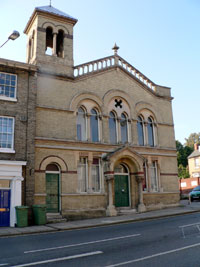
New Primitive Methodist Chapel
Formerly the Congregational Chapel |
|
1902
|
By 1902 the Primitive Methodist Congregation at 23A Garland Street had grown too large for the premises there. They decided to look at the considerably larger Chapel at 4 Northgate Street.
So from 1902 to 1934 there was a Primitive Methodist Congregation meeting at the former Congregational Chapel which stands on the corner of Looms Lane and Northgate Street. The main Methodist Church was well established not far away in Brentgovel Street, but the Primitive Methodists would not join the Wesleyan Methodists until 1934.
|
|
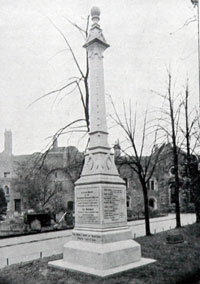
Protestant Martyrs Memorial
|
|
1903
|
The Martyrs' Memorial was unveiled by the Dean of Canterbury in the Churchyard at Bury on 23rd December, 1903. It was made to commemorate the 17 Protestant Martyrs who died in the town under the rule of Queen Mary, 1555 to 1558. It was erected by public subscription, and was designed and executed by A H Hanchet, Monumental Mason of Cemetery Road in Bury St Edmunds.
|
|
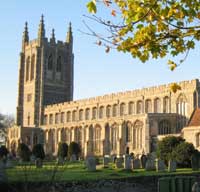
Melford Church today
|
|
blank |
Holy Trinity Church at Long Melford had suffered a lightning strike to its medieval tower around 1710, and the tower was subsequently demolished. A new tower had been rebuilt by 1725 in classical style in red brick. The red bricks had been covered in cement at some time, which in many places had broken away by the 1890s to give a scarred and ugly appearance. By the late 19th century it was considered that this tower was not appropriate for such a grand medieval wool church, and that it was sadly out of proportion to the rest of the building. In 1897, as part of Queen Victoria's Diamond Jubilee celebrations, the villagers set up a committee to raise funds and appoint an architect.
It was decided to build upon the old tower, and so it was decided to chip away the cement cladding and replace it with decorative flint work with stone stringing and detailing. Also to add corner buttresses with stone facing, and the first stone was laid in 1898. The result was a neo-gothic design which matched the old style of the main church, but further appeals for funds were needed in 1900 to raise the height of the tower. On 14th October, 1903 the "new" tower of 118 feet was dedicated by the Bishop of Ely.
The pinnacles of the old tower were removed, (and now reside at Melford Hall), while the new, grander pinnacles were named Victoria, Edward, Alexandra and Martyn, in honour of the late Queen and the new royal family.
|
|
1904
|
At the Congregational Church in Whiting Street a memorial was unveiled to Elias Thacker and John Copping, who were hanged in 1583 for their religious beliefs, "for disseminating the principles of independency".
The bells of St Mary's church at Haverhill were recast or restored, and a new bell added to bring it up to a minor ring of six. One of the re-cast bells had pre-dated the Great Haverhill fire of 1667.
|
|
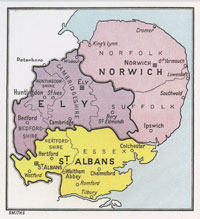
Current diocese areas |
|
1907
|
At this time Suffolk was divided into the two counties of East Suffolk and West Suffolk, and was also divided between the Diocese of Norwich, covering East Suffolk and the Diocese of Ely which included West Suffolk. The growth of population had made the existing diocesan situation untenable for administrative purposes. In 1889 a conference of all the local dioceses concluded that Suffolk should have its own diocese, as should Essex. Nothing much happened until the Bishop of Ely announced his retirement in 1904.
By 1907 plans and proposals were drawn up to redraw Diocesan boundaries to change the three dioceses of Norwich, Ely and St Albans, into five new units of Norwich, Ely, St Albans, Suffolk and Essex. It was also proposed that Bury St Edmunds should be the seat of the proposed new Bishop for Suffolk. However, rather than calling it the Diocese of Suffolk it was decided that it would be called St Edmundsbury and Ipswich.
It would take until 1913 for all these ideas to be debated, argued over, and slightly modified so that the new arrangements could come into operation in 1914.
|
|
1909
|
General Booth of the Salvation Army visited a number of towns and villages of Suffolk in the summer of 1909. The Stowmarket Weekly Post gave very full accounts of speeches he gave at Stowmarket and Bury St. Edmunds. Their issue for July 29th 1909 reported that,
"General Booth’s visit to Bury St. Edmunds in the course of his sixth motor tour was the occasion of great enthusiasm, not only amongst members of the (Salvation) Army but amongst all classes of the Community who gathered in large numbers to welcome one whose work has become world wide. On Monday afternoon, after leaving Stowmarket, the General’s progress through the villages on the road to Bury was a triumphant one. Everyone who could possibly get out lined the route, and gave him enthusiastic cheers. In some places, the enthusiasm showed itself by showers of flower bouquets and.....an admirer at Beyton Green very nearly caused the General a serious accident ....(when).. a bouquet of flowers intended for the car struck the General on the side of the face slightly injuring his nose."
|
|
1912
|
At Ousden, Sir Herbert Mackworth-Praed had been trying to sell the estate since 1908. In 1910 he reduced the price to £55,000. The Praed's had not lived at Ousden since buying the estate in 1863, but, nevertheless, they must have felt some obligation to the inhabitants.
Because of the rather isolated location of the Parish Church, the Praed family gave the people of Ousden a more convenient Burial Ground in 1912, which may be seen almost a mile to the east of the church. The parish church of St Peter's was located within the grounds of Ousden Hall.
|
|
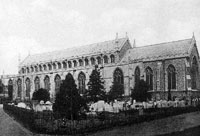
St James's Church
|
|
1913
|
For some years there had been a demand to have a Diocese for Suffolk. East Suffolk was in the Norwich Diocese, while West Suffolk was part of the Diocese of Ely. In 1913, an Act of Parliament created the New Diocese of St Edmundsbury and Ipswich. The first Bishop, Dr H B Hodgson, was enthroned in March 1914, but lived in Ipswich. The church of St James in Bury was designated to be the cathedral church of the Diocese. This reflected the ancient division of Suffolk into east and west, but also the fact that considerable work would be needed to bring what was a parish church up to the standards needed for a Diocesan Headquarters. Firstly the church itself needed extending, and not until 1970 would any substantial new works be completed.
In the absence of the Bishop, the cathedral was run by a resident Provost, who lived in the provost's house, which was the old Clopton's Asylum in the churchyard. It had already been the St James's Vicarage since 1897.
|
|
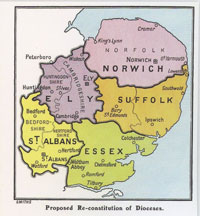
New dioceses as proposed 1907
|
|
1914
|
On January 21st, 1914, the old diocese of Ely, which included West Suffolk, and the old diocese of Norwich, which included East Suffolk, both ceased to exist. They were replaced by a new Diocese of Norwich which covered the greater part of Norfolk, and by the new Diocese of St Edmundsbury and Ipswich which covered most of Suffolk. A small area in north east Suffolk, the Deanery of Lothingland, would remain in the Norfolk Diocese. The Diocese of Ely was greatly reduced in size.
It had already been decided, in April, 1913, that the Church of St James in Bury St Edmunds, would be designated as the Cathedral of the new Diocese.
Considerable public discussion and controversy accompanied all these changes which had been debated ever since the initial proposals for change were set out in 1907. The diagram shown here demonstrates the original 1907 proposal. By clicking on the thumbnail you can also see the previous configuration in place since 1877.
Britain entered the First World War on 4th August 1914, and the regulars and territorials were mobilised.
At the commencement of World War I, the Railway Mission was opened as a “Soldier's Rest” from 5:30 to 6:30 am and 4 to 10 pm each day. Refreshments were sold and writing materials provided in a quiet, peaceful atmosphere. The soldiers who were billeted in the homes around had to meet at “The Rink” opposite (the site of the present Tesco supermarket) to collect rations and for drill etc. and they much appreciated this gesture.
|
|
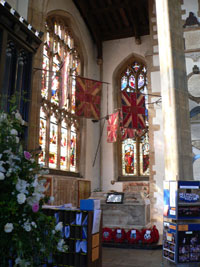
Suffolk Regimental Cenotaph
|
|
1920
|
In February the 1/5th Battalion of Territorials held a Reunion Dinner in the Corn Exchange in Bury, with 800 all ranks from across Suffolk in attendance.
On March 15th, the Suffolk Regimental Cenotaph was dedicated inside St Mary's Church in Bury. It was erected by subscriptions from all units of the Regiment. It was made of white alabaster and sculpted by A Whiffin to a design by W A Pite. Above it hang the flags of various battalions of the Regiment, laid up after the Great War. The picture from 2005 also includes memorials and flags from a later era.
|
|
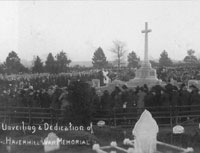
Haverhill's war memorial
|
|
blank |
On 21st November, 1920, the war memorial at Haverhill was dedicated and unveiled. It was unveiled in front of a very large crowd by Lt General Sir Charles Briggs. The memorial was in the form of a cross in stone, placed upon a substantial pedestal, around which were engraved 144 names of Haverhill's war dead. (A few of these names were added at a later date.) The memorial was located within Haverhill's cemetery, which itself was opened in 1867.
|
|
1931
|
The popular press used the term "tithe wars" to describe the refusal to pay tithe which was inevitably followed by the court bailiff's raid to seize farm goods for auction to pay the tithe and all the costs of the bailiff action. These wars peaked from 1931 to 1933.
The value of tithes was a burden on tithepayers but it rarely provided a living wage to the clergy meant to receive it. Thus any refunds due were a double blow to them. Often the vicars and parsons were in as much distress from the system of tithes as the farmers.
In 1931, at the Diocesan Conference in Bury St Edmunds, the Bishop of St Edmundsbury and Ipswich attempted to defend the ancient system. The Bishop knew that the Church would be called on to make up the shortfall as these payments fell away. Suffolk and Essex Tithepayers Associations attacked him in the press and at public meetings.
|
|
1932
|
Methodists had for a long time been organised into Circuits, whereby a minister would serve several different congregations as necessary. In 1932 the various strands of Methodist ministries decided to have Methodist Union, bringing together the Wesleyans, the Primitive Methodists and the Trinity Methodists. It is described by the Elmswell Methodist website as follows:-
"Like many other Circuits the Bury St Edmunds Circuit was affected by Methodist Union in 1932. For a couple of years the Wesleyan Circuit continued as the Bury St. Edmunds (Trinity) Circuit and the Primitive Methodist Circuit continued as the Bury St. Edmunds (Northgate Street) Circuit. In 1933 the Sudbury section of the Wesleyan Circuit was removed (together with the second minister) and together with certain other churches (presumably of Primitive Methodist origin) formed the Sudbury Circuit. This left the one minister in Bury and the lay pastor at Elmswell. In 1934 the two Bury St.Edmunds Circuits were amalgamated the ex-P.M. Churches in Bury and Ixworth being united with the ex-W. and Troston was added to this Circuit (from Thetford)."
|
|
1934
|
From 1902 to 1934 the Primitive Methodists in Bury St Edmunds had occupied the former Independant Chapel at 4 Northgate Street, on the corner with Looms Lane. Following Methodist Union, agreed in 1932, this congregation left Northgate Street in 1934 and joined the Trinity Methodist Church in Brentgovel Street.
|
|
1935
|
To celebrate the 250th anniversary of the Suffolk Regiment, the North Chapel of St Mary's church in Bury was to be converted into the Suffolk Chapel. Sir Ninian Comper completed his refurbishment of the Suffolk Regimental Chapel by the end of the year.
|
|
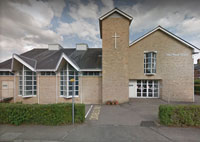 West Road Church today
West Road Church today
|
|
1939
|
The Plymouth Brethren moved out of town to a new chapel in West Road, on the corner with Queens Road, Bury St Edmunds.
|
|
1940
|
In January, as a special war time measure, the opening of cinemas on a Sunday was sanctioned in Bury for the first time.
|
|
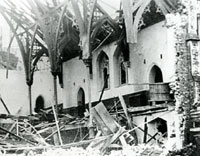 Destruction of Stowmarket Congregational Church
Destruction of Stowmarket Congregational Church
|
|
1941
|
On 31st January, 1941, a lone German bomber flew over Stowmarket. It was a day of low cloud and poor visibility, and the plane came in from the direction of Needham Market, flew over the town and then returned along Bury Street and Ipswich Street. A stick of bombs was dropped over Ipswich Street at approximately 12.05, midday, five of which hit the Stowmarket Congregational Church. Another bomb wrecked two houses in Kensington Road, killing Mrs Rhoda L Farrow, a widow aged 59.
Stowmarket Congregational Church had been built in 1861, and during wartime it was used as a refuge during air raid alerts. In the evenings a room was being used by the Berkshire Regiment as a Canteen and Rest Room. Luckily the church was empty when it was bombed. It was totally destroyed, and would not be replaced until 1955.
|
|
1942
|
In November, 1942, Winifred Challis, by then a clerk to the Public Assistance Committee (PAC) at Bury St Edmunds, began a diary for the research organisation known as Mass Observation.
She noted on 7th November, "Amusing! The Archbishops have after all these centuries decreed that women need not wear hats in church."
During November 16th church bells were rung for the first time since 13th June 1940 to celebrate the British victory in the desert, at El Alamein, over the Afrika Corps led by Rommel.
|
|
1949
|
Religion still seemed important to people although everybody knew that they would never return to the lives they had known before the war. At Chevington the village chapel was sold by the Congregationalists to the Methodists. The latter had been leasing it since about 1840. Within 10 years the congregation would drop to 8 people, worshipping only once a month.
|
|
1951
|
The growth of building on the Mildenhall Road council estate also led to the opening of St George's Church Hall in Anselm Avenue. It would be consecrated as a parish church in 1967.
|
|
1953
|
In May, 1953, a remarkable event occurred when the Augustinian order of Friars moved back to Clare Priory, having been absent since 1538. The Priory was a gift to them from the daughters of Lady May, who had wished to see the Friars return to Clare.
The parish of All Saints was created in 1953 to serve the growing population of Bury St Edmunds as the town spread westwards. The original All Saints church building was a multi-purpose Hall Church, which
was set up at the corner of Park Road and Highbury Road to serve the Priors and Horringer Court areas in Bury. This building would become the church hall in 1963 when a new church was consecrated adjacent to it.
|
|
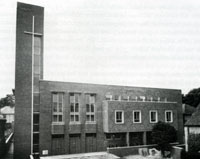 New Stowmarket Congregational Church
New Stowmarket Congregational Church
|
| 1955 |
During 1955 the new Congregational Church at Stowmarket was finally finished, on the site of the old church destroyed by German bombs in January, 1941. It was built by Sadlers of Ipswich, and was considered the epitome of modern ecclesistical architecture. Today it has become known as the United Reform Church.
|
|
1957
|
New housing continued to be built in Bury. On May 9th, the Mayor opened the 1,000th house built on the Mildenhall Road Housing Estate. The Northumberland Avenue Methodist temporary hall and the Plymouth Brethren's Lancaster Hall were both opened to serve the expanding area. The Lancaster Hall was actually located on Tollgate Lane.
|
|
1961
|
The spire which topped out Westley parish church's tower was removed, as it was thought to be unsafe.
In June 1961 the Village Chapel at Chevington was demolished. Its Methodist congregation had fallen to only eight by 1959, and it was sold to Thingoe Rural District Council in 1960, who would use the site for housing.
|
|
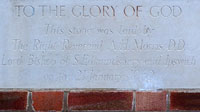
All Saints Foundation Stone
|
|
1962
|
This foundation stone for the new All Saints Church in Park Road, Bury St Edmunds, was laid by the Bishop of St Edmundsbury and Ipswich on 21st January, 1962. The new church was being built next to the existing All Saints church hall, and would be consecrated early in 1963.
|
|

All Saints spire
|
|
blank |
All Saints parish and its original hall had been set up in Bury St Edmunds in 1953. The site was in Park Road, and during 1962 a new church was built next to the original church hall. This view shows the spire being added to the church in December, 1962. It would be consecrated in 1963. It was a light, airy building that was much bigger inside than it seemed from the outside.
|
|
 Laying up the colours
Laying up the colours
|
|
1963
|
In 1963 the First East Anglian Regiment was granted the Honorary Freedom of the Borough of Bury St Edmunds. Its successor is the Royal Anglian Regiment, and the First (Royal Norfolk and Suffolk) Battalion retains this honour today.
On 30th November the colours of the 1st Battalion and the 4th Battalion of the Suffolk Regiment were laid up at St Mary's Church in Bury by colour parties of the 1st East Anglian and the Suffolk and Cambridgeshire Regiment.
|
|
1964
|
On the Mildenhall Road Estate the Methodists' temporary chapel in Northumberland Avenue was replaced by a permanent brick built church.
|
|
1965
|
Father Bryan Houghton of St Edmunds Catholic Church in Bury kindled a renewal of interest in the relics at Arundel, which he believed were the remains of St Edmund. He tried to have the remains returned to Bury St Edmunds. He did receive three teeth from the Basilica of St Sernin in Toulouse, but never succeeded in establishing widespread acceptance of his claims in Bury, and so the remains rest at Arundel. In 1970 he published a book about his attempts to prove his theories.
|
|
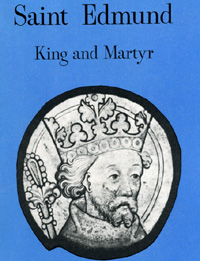 Father Houghton's book
Father Houghton's book
|
|
1970
|
In the same year that the Pageant entitled "Edmund of Anglia" was presented in the Abbey Gardens, Father Bryan Houghton produced his book entitled "Saint Edmund - King and Martyr". His book revolved around the thesis that the remains of St Edmund had been taken to France in July 1217, and had ended up in the Basilica of St Sernin at Toulouse. In 1901 these relics were brought to England, but rejected as authentic, and were lodged at Arundel. In 1964 and 1965 Father Houghton had tried to again have them authenticated and brought to Bury St Edmunds. The book records how he failed to convince others that this should be done.
|
|
1971
|
St Alban’s Voluntary Aided Primary School opened in Beard Road, on the Howard Estate, on 6th January 1971 as part of the three-tier Catholic comprehensive system of the Deanery. It had been agreed that all Catholic children over the full primary age range from the north of the railway line should transfer to St Alban’s that month, meaning that it would open with around 70 on roll. Children south of the railway line would attend St Edmund’s School but the transfer of children from that School would reduce its roll by 72. Unfortunately this agreement would not last and St Alban's would suffer a loss of numbers over the next three decades, finally closing in July, 2000.
St Louis Convent School became a state run Catholic School.
|
|
1972
|
Up to 1972 Whiting Street Church belonged to the Congregational Denomination.
With the ecumenical movement gathering momentum, the Congregationalists combined with the the Presbyterians to form a new denomination, the United Reformed Church. They see themselves as a mainstream protestant church, similar in many ways to the Methodists and Baptists.
Since then the Churches of Christ and Congregational Church in Scotland have become part of the United Reformed Church (URC) family.
In Bury St Edmunds the St John's Church School closed in St Johns Street, and the building became a Church Hall, used for a variety of community purposes.
|
|
1975
|
According to the Westgate Church website:-
"Westgate Chapel began life in February 1975 as a church plant from the village of Barrow, five miles outside Bury St Edmunds.
The small Congregational Chapel had been written off by the denomination as a lost cause. But in the late 1960s, Bob Cotton was called to pastor the church, and as the gospel was faithfully preached, and the people prayed, the church saw significant growth. Many people were attracted to the village chapel from Bury St Edmunds because of the evangelical Bible Ministry taking place there.
Responding to the need for a Bible-centred church in Bury St Edmunds, a monthly Bible rally was started by the Barrow church at Westley Middle School in 1972. The monthly meetings soon became weekly Bible studies, and then three years after the first Bible rally, the church formally began in February 1975 as Bury St Edmunds Evangelical Church.
|
|
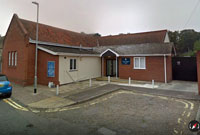 Westgate Chapel today
Westgate Chapel today
|
|
1976
|
During their first twelve months the Westgate Chapel congregation doubled in number. They started off meeting in Westley Estate Community Centre, and as the Lord was growing the church spiritually and numerically, it was felt that the church needed a permanent building within the town.
Eventually the church settled on purchasing its current building on Hospital Road near the town centre. Believing that the Lord was directing them in this way, the building was purchased in May 1976 and the church became known as Westgate Chapel. Originally a stable block for a pub, the building has gone through several incarnations, and has been extended three times since its original purchase.
It is located adjacent to the Hyndeman Centre.
|
| 1977 |
The agricultural tithe payers were finally relieved of any further payments in 1977. Without this Act they would have continued until 1996.
|
|
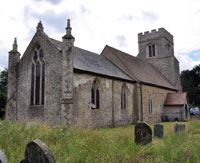
St Mary's Depden
|
|
1984
|
On the night of 23rd of June 1984, the church of St Mary, at Depden, was largely gutted by fire. This church stood about a third of a mile from the road, hidden amongst trees, and was only approached by a track across fields. The nearest building is Depden Hall (now a bed and breakfast), which is some 400 yards away and itself includes fabric reputed to date from the 14th century. The village itself has fragmented into settlements at Depden Green to the North and along the A143 to the East of the church and hall. Within three weeks the debris was cleared by volunteers, and a service was held in the roofless remains, albeit within the Sanctuary only. An insurance claim of £100,000, and a local appeal of £10,000, allowed the roof to be replaced, and the church was back in action by October, 1985.
|
|
1985
|
According to the website, https://bury-st-edmunds.adventistchurch.org.uk/history-of-local-adventist,:-
"In 1985, Robert Surridge, the Adventist pastor from Gorleston, near Yarmouth, and Jonathan Gallagher, pastor in Cambridge, joined forces to bring the Adventist message to Bury St. Edmunds. They did house-to-house visitations and contacted known S.D.A. Believers in and around Bury, as well as those on the U. S. Air force bases at Lakenheath and Mildenhall.
The group of interested persons started meeting for worship and Bible study in the Guildhall, about September 1985. As Robert Surridge writes, “Jonathan and I found the Guildhall whilst trying to get out of a rain storm and I know that it served the church well as a home for many years.”
The group was officially organised by Pastor Sven Ohman as a “Church” on 12th October, 1991 with 24 charter members. They met at the Guildhall until 2001 when the Railway Mission Hall became available.
Adventists meet on Saturdays which they regard as the Sabbath.
|
|
1987
|
In August 1987, British Rail decided to sell the land on which the Railway Mission Hall stood in Fornham Road, Bury St Edmunds. As landlords they also claimed the right to sell the buildings which stood on the site. The Mission Hall had been erected by subscription in 1900, and to secure its future the congregation was now being asked to buy back what it had itself provided. At the auction in November, British Rail were forced to withdraw the mission hall itself from the sale, because it was proved to be a temporary structure, being what is known as a "tin tabernacle", with a corrugated iron roof and cladding. The Church still had to buy the land upon which the Mission Hall stood for £29,000. Most of this price had to be raised by an appeal. After this a new church was formed and in 1990 it would become called the Fornham Road Free Church.
|
|
1990
|
The cathedral of St James opened its new facilities for meetings and conferences, as another step forward in making it fit for the headquarters of the diocese. Called the cathedral centre, it included the Refectory.
|
|
1991
|
In Churchgate Street the refurbishment and conversion of the Unitarian Chapel was completed. It could now be let out for public functions as well as continuing as a place of worship.
|
|
1992
|
In West Road, the Plymouth Brethren re-opened their modernised and enlarged church.
|
|
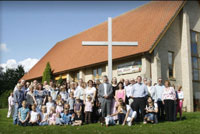
Christ Church Moreton Hall
|
|
1993
|
In 1983 Christ Church, Moreton Hall, was planted by a single group of Christians from different denominations at the instigation of the Council of Churches for Bury St Edmunds, with the consent of the vicar of St Mary’s.
It has always been envisaged that Christ Church Moreton Hall would be a single body working ecumenically in the clearly defined mission area of Moreton Hall estate.
In December, 1993, the church at Moreton Hall opened for its first service at Lawson Place, Symonds Road, Bury St Edmunds.
|
|
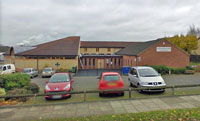
Christian Research Centre
|
|
blank |
Also in 1993 the Beacon Church and Christian Resource Centre was founded at Oakes Road in Bury St Edmunds. The Beacon Church denomination is recorded as Assemblies of God, Pentecostal, exercising contemporary worship.
|
|
1994
|
The Sunday Trading Act 1994 came into force in July. This allowed small shops unlimited opening hours on Sundays. Large shops were restricted to 10am to 4pm on Sundays.
Stephen Dykes Bower, the cathedral architect, first appointed in 1943, died in 1994. He left nearly £2 million towards the completion of the tower and works to St James's Cathedral. Suddenly there was the prospect of completing his design for Bury's cathedral church.
At Moreton Hall there had been great development of private housing, industry and commerce. Some major shopping outlets were now located here, and a new Anglican parish was established here in July, 1994. Christ Church was set up by the Church of England, but run on ecumenical lines.
|
|
1999
|
In Bury, work began on building a new tower for the Cathedral.
|
|
2000
|
In July, 2000, the St Alban's Roman Catholic Primary School in Beard Road, on the Howard Estate, was forced to close. Its numbers had dwindled down to only 25 by the end. It had opened in 1971 with a rollcall of around 70, to serve the area north of the railway line. However, many parents had continued to send their children to the established St Edmunds Catholic School. After closure the land and its buildings were leased to Suffolk County Council for use as a referral unit for approximately 30 pupils who had difficulty adapting to mainstream education.
|
|
2001
|
The Guildhall had long been unsuitable for its remaining use as a casually let public building. During 2001 it was let on a short term basis to the Theatre Royal Youth Group, as rehearsal rooms and offices.
One of the casualties of the new arrangements at the Guildhall was the congregation of the local Seventh Day Adventist Church. They had met at the Guildhall for some years, but now had to look for other accomodation. In the short term, they moved to the St John Ambulance Hall, but then heard that the Fornham Road Free Church had dwindled to a level where they decided to sell their building. They resided in the "tin tabernacle" by the railway bridge in Fornham Road, which was the well known landmark usually still referred to as the Railway Mission. The Seventh Day Adventists acquired the building for £35,000, and found out that it had been made a Grade 2 listed building in 1996. This meant that all improvements would need listed building consent, and so careful plans and more money were needed to refurbish it. The work would be completed in May 2005.
During 2001 work began on the new cathedral tower. Prince Charles laid the first brick. It was soon discovered that much of the pre 1970 work on making the crossing to support the tower was now not considered up to the job. Much of this had to be removed before the new work could begin.
|
|
2002
|
During 2002 the Railway Mission Hall was bought by the Seventh Day Adventists Church. They had plans to improve it. It had been the Fornham Road Free Church since 1990, and was sold to the Adventists for £35,000. As a surviving tin tabernacle, it is a Grade II listed building.
|
|
2004
|
The new 150 feet tall Cathedral Tower at Bury St Edmunds had not been finished by the end of 2003 as originally planned, but was finally topped out in October, 2004.
By December the protection around the Cathedral scaffolding began to be removed, and the public could see the four spires at the top of the tower for the first time.
Delays had been caused by expanding the work to include new cloisters, and were expected to be fully completed by 2005.The Tower was a Millenium Project and received £5.5 million in grant aid from the Millenium Commission, itself financed from the National Lottery. A further £2.7 million came from the estate of Stephen Dykes - Bower, the architect who undertook the cathedral's extensions during the 1970's.
|
|
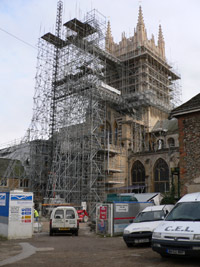
Unveiling the Tower
|
|
2005
|
During February the new Cathedral Tower was gradually revealed to the town as the protective wrapping and scaffolding was slowly removed. Songs of Praise, the television programme was due to be broadcast from here in March, so efforts were made to be ready for this event.
|
|
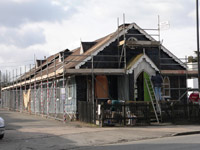
Mission Hall improvements
|
|
blank |
Another religious building to be given an upgrade in February 2005 was the old Railway Mission Hall on Fornham Road. This example of a Tin Tabernacle from the turn of the century had its exterior cladding of corrugated metal sheets replaced and new windows installed for the Seventh Day Adventist Church.
|
|
2006
|
The first turf was cut on a new £570,000 project on the Mildenhall Estate to replace St George's Church hall in Anselm Avenue by a new Community centre. It was hoped to open it in December 2006.
|
|
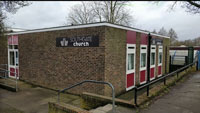
Southgate Church
|
|
blank |
The Southgate Church, meeting at Southgate Community Centre, was incorporated as a private limited company in May, 2006. Church meetings had been held at the Centre for many years. Today the church website declares; "We are a Local Ecumenical Partnership between the Church of England, the United Reformed Church and the Baptist Union of Great Britain. We welcome anyone to worship with us, whatever your church or denominational background."
|
|
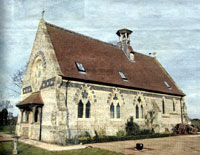
New life at Culford Heath
|
|
2012
|
A little known religious building was put up for sale in February. This was the former church of St Peter's at Culford Heath, a remote community which had all but died out at the end of the 20th century. By 2000 most of the cottages, the church and a schoolhouse were derelict. Over the last three years the church was converted into a private dwelling, and work was well advanced on several old cottages nearby. Culford Heath had once been a stop on the now defunct Bury to Thetford railway line, and can still only be reached up an unmade farm road. The chapel was built in 1863 by Edward Benyon, the owner of the Culford estate, as was the school house of 1840. The cottages were somewhat earlier.
|
|
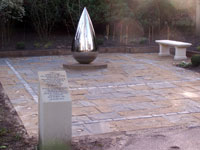
Holocaust Memorial Garden
|
|
2015
|
On 27th January the annual Holocaust Memorial Service in the Abbey Gardens was enhanced by the opening of a new memorial garden. This was designed and financed by The Bury St Edmunds Memorial Garden Fund, a charitable trust set up for the purpose. The Trust raised some £10,800 to pay for the project. The project's starting point was the realisation that very few local people knew anything about the 12th century massacre of Jews in the town, which (unlike instances of later religious persecution) had not been commemorated in any monument. The Fund website also explains, "The massacre took place on Palm Sunday, 19th March, 1190, when anti-Jewish feelings would have been at their height, with people blaming Jews for Christ’s crucifixion. It was also a time of heightened religious and military fervour, as King Richard I was then recruiting soldiers to join his crusade to the Holy Land."
The design includes 57 paving slabs, in memory of the victims of the massacre, and features a teardrop sculpture manufactured from polished stainless steel. This measures approximately 1.5m high and 0.75m wide (5’ x 2’6’’).
Two benches are intended as aids to quiet contemplation. One is dedicated to all who have suffered from acts of genocide and persecution. The other is dedicated to the 57 Jews who were massacred here in Bury St Edmunds, on Palm Sunday, 19th March, 1190.
|
|
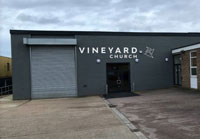
Vineyard Church
|
|
2017
|
In March, 2017, the West Suffolk Vineyard Church acquired premises at 28 Northern Way trading estate for conversion into a church meeting place. West Suffolk Vineyard is a contemporary Christian church passionate about Jesus and living out his teachings. Although based in Bury St Edmunds in Suffolk, people are drawn from neighbouring towns and villages.
|
|
2020
|
Following the latest Government guidance for Places of Worship, churches can resume meetings again. From the 19th July, The Potters House resumed meetings at their new Church location at the Bury Town Football Club, Ram Meadow, Cotton Lane, Bury St Edmunds.
Previously the Pentecostal Potters House had met in the primary school in Grove Road, Bury St Edmunds.
|
|
Quick links on this page
Top of Page 1900
New C of E Dioceses 1914
St George's 1951
All Saints 1962
Free Church 1987
Seventh Day Adventists 2002
|
|
Next Section
|
If you click Next Section you will return to the first of these religious themed pages.
|
Prepared for the St Edmundsbury Local History Project
by David Addy, July 17th, 2020
|



























